|
Nothing to Get Depressed About
by Bob Brooke
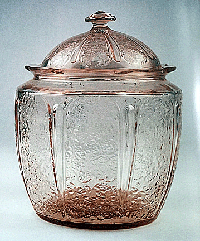 Of
all the collectibles out there, Depression glass is one of the most
popular with collectors, most likely for its rainbow of colors and its
myriad of patterns. Depression glass is far from a depressing
collectible. In fact, companies made it in such bright colors to raise
the mood of people going through one of the worst times in their lives.
They also made it affordable so that this little bit of joy could reach
as many people as possible. Of
all the collectibles out there, Depression glass is one of the most
popular with collectors, most likely for its rainbow of colors and its
myriad of patterns. Depression glass is far from a depressing
collectible. In fact, companies made it in such bright colors to raise
the mood of people going through one of the worst times in their lives.
They also made it affordable so that this little bit of joy could reach
as many people as possible.
The common belief is that this clear, colored translucent, or opaque
glassware got its name because it was made during the Great Depression.
This is a bit of a misnomer because decorative glass of this type had
been around since as early as 1914 and as late as 1960. However, the
production of Depression glass did indeed reach its peak during the
years of the Great Depression.
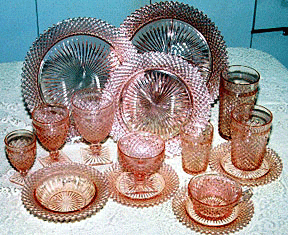 During
the first half of the 20th century, the Ohio River Valley was the
epicenter of glass production. Companies like Westmoreland and Fenton
Glass had access to the raw materials and power they needed to keep
their glass production costs down. Over 20 manufacturers made more than
100 patterns of Depression glass, some in entire dinner sets, from the
1920s to the 1930s. During
the first half of the 20th century, the Ohio River Valley was the
epicenter of glass production. Companies like Westmoreland and Fenton
Glass had access to the raw materials and power they needed to keep
their glass production costs down. Over 20 manufacturers made more than
100 patterns of Depression glass, some in entire dinner sets, from the
1920s to the 1930s.
The glass of this period is broken down into two different types,
Depression glass and Elegant glass. Depression glass and Elegant glass
differ in that Elegant glass had hand-finishing work done to it after it
was removed from the mold. This included removing mold marks, grinding
the bottom for flattening, and etching or engraving the piece. Elegant
glass was made by a smaller number of companies because the hand
finishing decreased profit margins. Depression glass is further broken
down into 'known patterns' and 'generic glass.' Known patterns have been
well documented. Generic glass was made during the Depression glass
period but it does not fit into a named pattern designation.
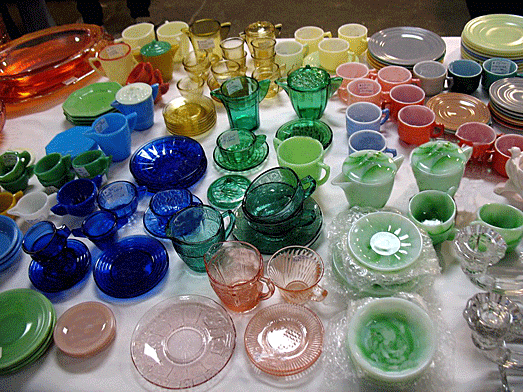
Although mass production of this low-quality molded glass made it fairly
inexpensive at the time, not everyone could afford it. Everyday
essentials were far more important, but thanks to glass companies like
Indiana, Imperial, Federal, Jeanette, Hazel Atlas, and Anchor Hocking,
the wares were available to everyone for a few pennies or nothing.
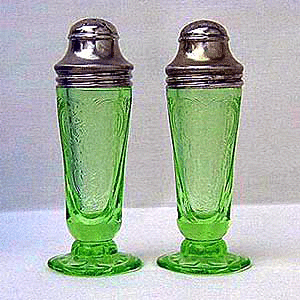 For
instance, a bag of Quaker Oats flour might include a premium piece of
dinnerware. The company also made laundry detergent, in which it
packaged “a little extra something” to make the drudgery of washday more
bearable. The pattern, size, and color were a mystery to the user until
she opened the box. Collecting the pieces to use became a common pastime
and made people’s lives a little brighter. Other companies followed
Quaker Oats’ lead and began using Depression glass as a premium to help
sell their products. For
instance, a bag of Quaker Oats flour might include a premium piece of
dinnerware. The company also made laundry detergent, in which it
packaged “a little extra something” to make the drudgery of washday more
bearable. The pattern, size, and color were a mystery to the user until
she opened the box. Collecting the pieces to use became a common pastime
and made people’s lives a little brighter. Other companies followed
Quaker Oats’ lead and began using Depression glass as a premium to help
sell their products.
Depression glass pieces also lined the shelves at five-and-ten-cent
stores like Woolworth’s or if people went to the movies on Tuesday or
Wednesday nights when patronage was low, they might win a set of dishes.
Some theater owners handed out small pieces just for attending a show.
Depression Glass Patterns
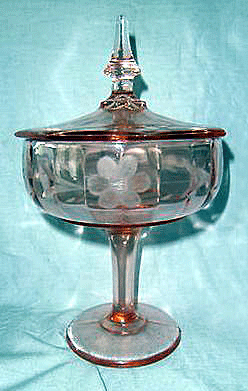 here
are 92 different patterns that have been well documented for the
Depression glass collector. These include Adam, American Sweetheart,
Block Optic,Cherry Blossom, Dogwood, Floral, Georgian, Hobnail, Lake
Como, Manhattan, Starlight, and Windsor as a brief sampling. The best
way to identify these patterns is find pictures of them so you know what
they look like. Some of the names are fairly self-explanatory, such as
Cherry Blossom, but most are not. here
are 92 different patterns that have been well documented for the
Depression glass collector. These include Adam, American Sweetheart,
Block Optic,Cherry Blossom, Dogwood, Floral, Georgian, Hobnail, Lake
Como, Manhattan, Starlight, and Windsor as a brief sampling. The best
way to identify these patterns is find pictures of them so you know what
they look like. Some of the names are fairly self-explanatory, such as
Cherry Blossom, but most are not.
The Cherry Blossom pattern, made by the Jeanette Glass Company from 1930
to 1939, came in both pink and green. While most collectors of
Depression glass favor the color green, it also came in a rainbow of
other common colors, including crystal (clear), pink, pale blue, green,
and amber. Less common colors included canary (yellow), ultramarine,
jadeite (opaque pale green), delphite (opaque pale blue), cobalt blue,
ruby (red), black, amethyst, and milk glass (opague white).
Later Depression Glass, made during the 1940s and 1950s, included
American Prescut, sold only in clear crystal, and other patterns in ruby
and forest green. The top-of-the-line pattern has always been Pink Miss
America, made by the Hocking Glass Company from 1935 to 1938.
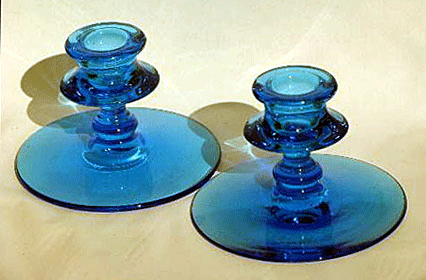 While
over 100 companies made Depression Glass during the Great Depression, by
the time it had ended, only half that many were still producing it. And
of these, only seven—Federal, Hazel-Atlas, MacBeth-Evans, and U.S.
Glass—produced this glass exclusively through the mid-1940s. While
over 100 companies made Depression Glass during the Great Depression, by
the time it had ended, only half that many were still producing it. And
of these, only seven—Federal, Hazel-Atlas, MacBeth-Evans, and U.S.
Glass—produced this glass exclusively through the mid-1940s.
The Imperial Glass Company produced the first pattern, Fancy Colonial,
in 1914, well before the Great Depresssion began. Westmoreland Glass has
the distinction of making the English Hobnail pattern the longest.
Depression Glass Colors
The most popular colors of glassware were amber, blue,
green, pink, and yellow. There were also pieces produced in amethyst,
black, colbalt, crystal, cremax, custard, delphite, iridescent, frosted
and dark green, ivory, and jadeite.
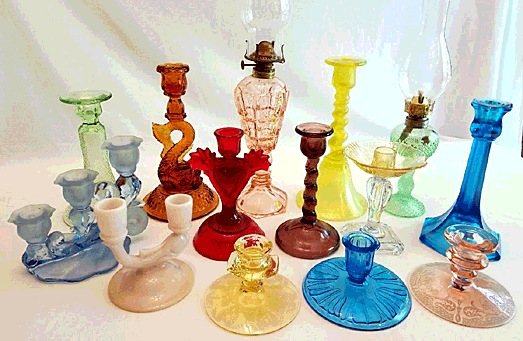
The most colors made for any one pattern are 11, done for Moondrop and
Rock Crystal, followed by English Hobnail by Westmoreland, Lincoln Inn
by Fenton, and Floral by Jeanette, all with 10 colors each.
Identifying Depression Glass
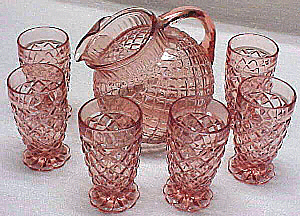 While
Depression glass has a distinctive look no matter who made it,
identifying the different companies and patterns can be confusing. And
the reproduction of some Depression glass patterns in the 1980s only
adds to the confusion. And identifying Depression glass by mark can be
difficult because few of the companies marked or labeled their wares. While
Depression glass has a distinctive look no matter who made it,
identifying the different companies and patterns can be confusing. And
the reproduction of some Depression glass patterns in the 1980s only
adds to the confusion. And identifying Depression glass by mark can be
difficult because few of the companies marked or labeled their wares.
The best way to determine a genuine piece of Depression glass is to
learn the pattern, dates of manufacture, colors the pattern was produced
in, and any other known identifying
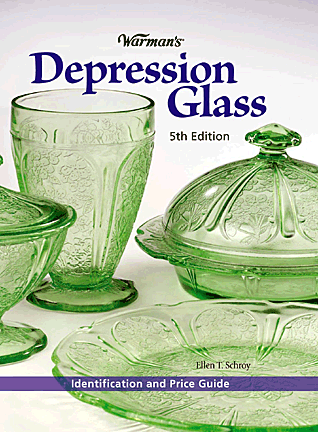 marks.
They do not usually have the manufacturer mark stamped on them. One
example is the Cherry Blossom pattern by the Jeannette Glass Company.
This was introduced in 1930 and produced until 1939. There were 43
pieces in the set and it was made in seven different colors: green,
pink, crystal, yellow, ruby, jadeite, and dark green. This is one of the
most popular collector sets and there are reproductions circulation to
watch out for. marks.
They do not usually have the manufacturer mark stamped on them. One
example is the Cherry Blossom pattern by the Jeannette Glass Company.
This was introduced in 1930 and produced until 1939. There were 43
pieces in the set and it was made in seven different colors: green,
pink, crystal, yellow, ruby, jadeite, and dark green. This is one of the
most popular collector sets and there are reproductions circulation to
watch out for.
The only way to identify a maker is to know which company made the
pattern. Using the numerous books and Web sites on Depression glass
available today, it’s a fairly easy process. Some of the most common
include Adam, American Sweetheart, Block Optic,Cherry Blossom, Dogwood,
Floral, Georgian, Hobnail, Lake Como, Manhattan, Starlight, and Windsor.
While some of the names reflect the style of the glass pattern itself,
most do not.
Reproductions
 Identifying
fakes is a matter of knowing exactly what pieces were made for that
particular set, and what colors were used. If you know the colors and
pieces the pattern was originally produced in, you can identify a
reproduction when it does not fit the known data. Cherry Blossom
reproductions were first made starting in 1973 with a child's size
butter dish. This was not a piece made by Jeannette Glass Company, as
documented by Hazel Marie Weatherman, so it was recognized as a fake. Identifying
fakes is a matter of knowing exactly what pieces were made for that
particular set, and what colors were used. If you know the colors and
pieces the pattern was originally produced in, you can identify a
reproduction when it does not fit the known data. Cherry Blossom
reproductions were first made starting in 1973 with a child's size
butter dish. This was not a piece made by Jeannette Glass Company, as
documented by Hazel Marie Weatherman, so it was recognized as a fake.
Depression glass was never made to be durable as it was only made to
meet people’s immediate needs. Due to its popularity as a collectible
and its breakability, Depression glass is becoming harder to find. Rare
pieces often sell for several hundred dollars. Popular and expensive
patterns and pieces have been reproduced, and reproductions are still
being made, which has watered down the market for some patterns.
<
More Special Features
Next Article > |
